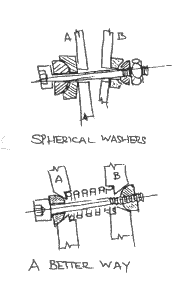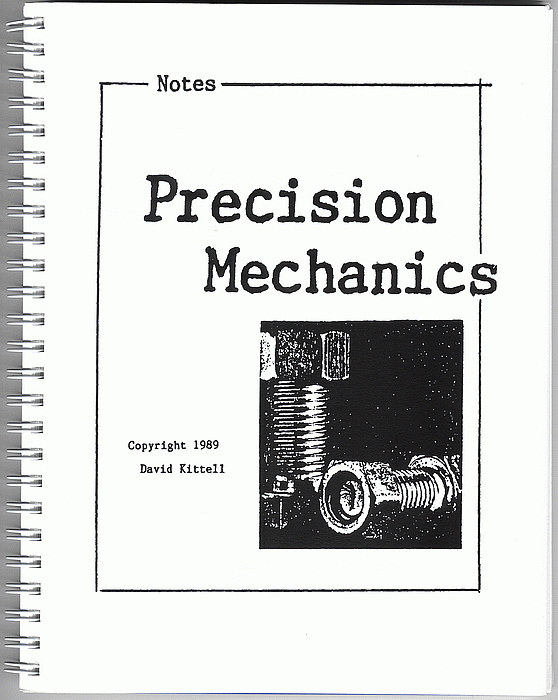|
|
|
|

Precision Mechanics
by David Kittell
The little blue book
|
|
Understanding
of these basic kinematic concepts will unleash your machine design
understanding.
David
Kittell, the father of the discipline,
Precision
Mechanics, shares the foundation of this science with you in his
highly practical and fun to read book, Precision Mechanics.
Based on his highly acclaimed course by the same name, first taught at
the Perkin-Elmer Technical institute in Norwalk, Connecticut, and later as a
short course offered in such places as Bell Labs, SPIE, IEEE, NASA, and several
national labs, you will find this book relevant and immediately useful.
Precision
Mechanics,
offers you insight into:
·
What
makes a machine stable enough to measure angstroms, but made with parts made in
a regular machine shop with common tolerances and materials (mostly).
·
How
these same principals help your bolts stay tight in vibrating machines
·
Ways to make your adjustments stay where you put them, without lots of
expensive parts.
·
Why flexure bearings are often at an advantage over pivots.
This book is
offered for $34.95 plus shipping. 56 pages, spiral bound to lay flat.
|

|

Table of Contents
Introductory Dialog 1
Rigid Body Mechanics 6
Flexure Kinematics 12
Rolling Kinematics 21
Adjustments 22
Holders, Clamps and Locks 32
Structures 40
Configuration 44
Sensors 51
|
About the author:
David Kittell, Founder and President of Sage Systems, was a
designer and builder of precision instruments and machines for
more than 30 years. During his early career, he worked on high
performance optical drum scanners for Time, Inc., contributing
to many innovations to the field. He was the architect of the
computer controlled polisher used to polish the now infamous
Hubble Space Telescope mirrors. He was recently a principal
scientist with Hughes Danbury Optical Systems in Connecticut,
doing work on deformable mirrors and adaptive optics. He held
an engineering degree from the University of Connecticut.
|
$38.00 per copy
|
|
|
Who is this book for? Precision
Mechanics is for engineers and technicians, for machine designers
and machinists, managers and mechanics.
What do I need to know to benefit from
this great book? This book will be of interest
to people with a technical interest in the design and building
of machines. Some familiarity with these things is helpful
for context.
What practical benefits can I expect
from Precision Mechanics? You can expect to have
a more complete understanding of what makes a machine stable.
You will understand the concepts of degrees of freedom and understand
why 6 of them are the magic number.
What if I don't like it??
The chances are so low that you won't like your book,
that we will give you a full refund plus your shipping if you
mention this guarantee! (No one has ever asked for a refund
yet.)
People have "the little blue book"
open on their desk long after the first read.
|
|
Precision Mechanics - The
short course
Now being offered again as a three
day course based upon the original courses and taught by
his long trained son.
|
Precision Mechanics Course Outline
OBJECTIVES:
To provide
participants with practical techniques and
approaches for the engineering design of
instruments and precision devices.
WHO SHOULD ATTEND:
Engineers,
scientists, technicians, machinists, or anyone
who needs to create instruments, mechanisms,
mounts, fixtures, adjusting, or supporting
devices with precision performance requirements.
COURSE OUTLINE:
The
course begins with the concept of kinematic
design and then addresses how to create
practical elements for kinematic mounts. It goes
on to discuss flexures for small displacements
and rotations, wire flexures for 5 DOF coupling,
methods for precision adjustments, holding,
clamping and locking methods, considerations in
supporting structures, their stiffness,
vibration, and damping, stick-slip, Hertzian
contact stresses, stability over time and
temperature, and many examples that show how
these methods can be integrated to achieve a
desired result. Model shop and experimental lab
techniques are often referenced. Intuitive
understanding of fundamental principles is
emphasized. Measurement components and
application to the sub-micron world are
discussed.
Instructor:
Jake Kittell,
The
Principal Engineer at Happiness Tech LLC has
been designing and building precision machines
and robots for 20+ years and holds an
engineering degree from the University of
Connecticut.
|
|
Day 1 |
Introduction What is precision mechanics? What
are we trying to do? Units, particular
challenges, Opportunities Rigid body Kinematics
Kinematic relationships, degrees of freedom,
stability, practical applications Flexure
Kinematics What flexures are, pros and cons,
degrees of freedom, practical applications
|
|
Day 2
|
Rolling Kinematics Rolling element bearings,
kinematic relationships, stability,
repeatability Adjustments Feedback, precision,
accuracy and stability, interdependence and
arrangement. Resolution vs. range. Practical
applications Holders, Clamps and Locks
Considerations for stability, practical
applications. Screws, the fine details.
|
|
Day 3
|
Structures Holding it all together,
relationships, stiffness, stability, resonance,
Q. Configurations Mechanisms, precision
mechanics in practice, considerations, degrees
of freedom. Sensors, Actuators and Control
Selection, sources of error, Range, resolution,
target, linearity, location, dynamic range,
stability.
|
|
|
Please inquire for available dates and pricing
to have this course at your facility.
|
|
|

